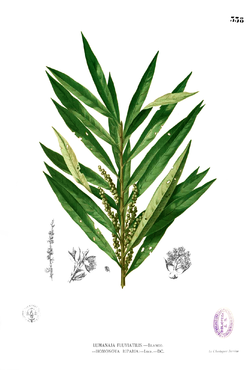| Homonoia | |
|---|---|
 | |
| Homonoia riparia [1] | |
| Scientific classification | |
| Kingdom: | Plantae |
| Clade: | Tracheophytes |
| Clade: | Angiosperms |
| Clade: | Eudicots |
| Clade: | Rosids |
| Order: | Malpighiales |
| Family: | Euphorbiaceae |
| Subtribe: | Lasiococcinae |
| Genus: | Homonoia Lour. |
| Type species | |
| Homonoia riparia | |
| Synonyms [2] | |
Homonoia is a plant genus of the family Euphorbiaceae first described in 1790. [3] [4] [5] [6] These are rheophytes and usually found in groups at riverbanks in India, southern China, Southeast Asia, and New Guinea. [7] [8] [9] [10]
- Species [2]
- Homonoia intermedia Haines - India
- Homonoia retusa (Graham ex Wight) Müll.Arg. - India, Vietnam
- Homonoia riparia Lour. - Guangxi, Guizhou, Hainan, Sichuan, Taiwan, Yunnan, Cambodia, India, Assam, Bhutan, Sri Lanka, Borneo, Java, Lesser Sunda Islands, Sulawesi, Sumatra, Maluku, Laos, Malaysia, Myanmar, Philippines, Thailand, Vietnam, New Guinea, Andaman & Nicobar Islands
- formerly included
moved to other genera (Lasiococca Spathiostemon)
- Homonoia comberi - Lasiococca comberi
- Homonoia javensis - Spathiostemon javensis
- Homonoia pseudoverticillata - Lasiococca comberi
- Homonoia symphyllifolia - Lasiococca symphyllifolia